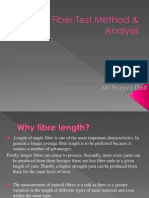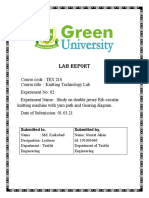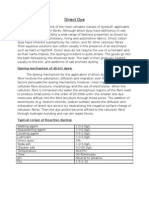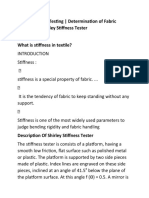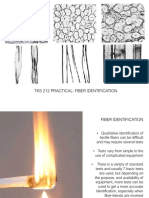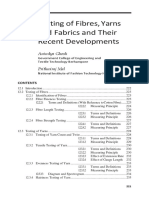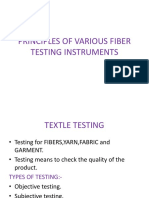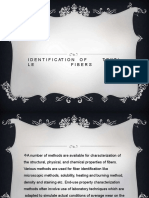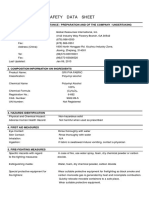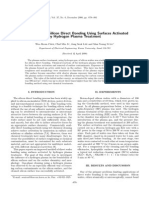BGMEA University of Fashion & Technology (BUFT)
Lab Manual
For
TEX2206: Textile Testing and Quality Control-I [LAB]
Department of Textile Engineering
BGMEA University of Fashion and Technology (BUFT)
Prepared by
Fahmida-E-Karim
Lecturer
Dept. of TE
1
� INDEX
Ex.
Experiment Name
no
01 Study on Layout Plan of TTQC Lab.
02 Identification of textile fiber through Microscope appearance
in Laboratory.
03 Identification of textile fiber through burning test and
chemical solubility test.
04 Determination of fiber fineness by air flow method of cotton
fiber.
05 Determination of cotton fiber length using comb sorter
machine.
06 Determination of Moisture regain & Moisture content of
cotton fiber by rapid dryer.
07 Determination of Yarn count using Beesley’s Balance.
08 Determination of Yarn count and count variation using wrap
reel.
09 Determination of Yarn strength and C.S.P using lea strength
test.
10 Determination of Yarn TPI of cotton yarn using ordinary
twist tester.
2
�Experiment No: 01
Experiment Name: Study on Layout Plan of TTQC Lab.
Introduction: Layout means the way in which the part of something are
arranged or laid out. It is very important part of a room or company, which is,
help us to understand machine setup in there.
Objective: To know about Textile Testing & Quality Control (TTQC) lab machine
name and their specification. Also know about different types of machine
functions.
3
��Machine name & specification with their function:
01. Martindale Abrasion and Pilling Tester
Brand: James Heal
Company name: James H. Heal and Co-ltd.
Origin: UK
Function: To determine the abrasion and pilling resistance of textile
structure.
02. Yarn Twist Tester
Brand: MAG
Instrument name: Mec Twist
Company name: MAG Solvics Private Ltd.
Origin: India
Function: To measurement the TPI (Twist per inch)
03. Oven Dryer
Company name: SDL International Ltd.
Origin: UK
Function: To dry textile substance
04. GSM Cutter
Origin: China
Function: To measure the GSM
05. Crock Meter
Brand: Parameunt
Origin: India
Function: To determine color fastness and rubbing of fabric
5
�06. Beesely’s Balance
Brand: MAG
Instrument name: Fabycount
Company name: MAG-Solvics private Ltd.
Origin: India
Year of origin: 2016
Function: To determine the yarn count of fabric
07. Fabric Drape Tester
Brand: Paramount
Company Name: Paramount group
Origin: India
Function: To feel the drape ability
08. Wrap reel
Brand: MAG
Instrument name: Mec Wrap reel
Company name: MAG Solvics private Ltd
Origin: India
Function: To determine the yarn count or length
09. Comb Sorter
Brand: MAG
Instrument name: Mec Wrap reel
Company name: MAG Solvics private Ltd
Year of origin: 2018
Function: To determine the fiber effective length
6
�10. Fiber Fineness (Micronaire) Tester
Brand: MAG
Instrument name: Fibro Mic XT
Company name: MAG Solvics private Ltd
Origin: India
Year of origin: 2013
Function: To measure fiber fineness
11. Crimp Tester
Brand: MAG
Instrument Name: Accu Crimp 2F
Company Name: MAG Slovics Private Ltd
Origin: India
Year of origin: 2014
Function: To measure crimp percentage of fabric
12. Thermohygrometer
Brand: Local
Origin: China
Function: To determine the moisture
13. Perspirometer
Brand: SDL-Atlas
Origin: UK
Function: To use for color fastness to persipation of fabric
14. Electronic Precision Balance
Capacity: 0.01 gm to 620 gm
Brand: AND-GULF, UAF
Function: To measure the GSM balance
7
�15. Microscope
Brand: Micros
Company name: Micros
Origin: Austria
Function: To observe the cross-sectional view of fiber
16. Course Length Tester
Brand: TESTEX
Origin: China
Function: To find out the course length.
17. Yarn Strength tester
Brand: MAG
Instrument name: Mechtrentch XT
Company name: MAG Solvics private Ltd
Origin: India
Function: To break down the yarn strength.
8
�Experiment No: 02
Experiment Name: Identification of textile fiber through Microscope
appearance in Laboratory.
Introduction: A microscope is a scientific instrument. It makes small objects
look larger. This lets people see the small things. Microscopes make things
seem larger than they are, to about 1000 times larger. This is much stronger
than a magnifying glass which works as a simple microscope.
Objective: To identify of textile fiber through microscope appearance, this
machine shows us longitudinal view of these. Cross-section view to help
identify fiber very well but, in our lab, we can’t show this view.
Machine Specification:
Machine Name: Micros
Model: MC-50 series
Magnification Range: 40x – 100x
No. of Objective lens: 4
9
�Machine Description:
10
� Eyepiece / Ocular Lens: Magnifies the specimen image. It is where you
look through to view the object placed on the stage.
Diopter Adjustment: Useful as a means to change focus on one eyepiece
so as to correct for any difference in vision between your two eyes.
Nose Piece: It holds the objective lenses and can be turned to increase
the magnification.
Mechanical Stage: A mechanical stage is used when working at higher
magnifications where delicate movements of the specimen slide are
required.
Condenser: Gathers and focuses light from the illuminator onto the
specimen being viewed.
Illuminator: A steady light source (110v) used in place of a mirror.
Base: Supports the microscope and is also used for carrying the
microscope.
Objective Lenses: It is used to magnify the images of the specimen to
form an enlarged image.
Arm: It is the frame to which the base, body and stage are attached.
Coarse Adjustment: Brings the specimen into general focus.
Fine adjustment: Fine tunes the focus and increases the detail of the
specimen.
Light Switch: This switch on the base of the microscope turns the
illuminator off and on.
Working procedure:
This experiment about identification of textile fiber by microscope, there has 7
different types of fiber like Cotton, Flax, Acrylic, Hemp, Glass, Carbon, Kevlar.
That microscope has 4 lens and magnifying capacity was 40x -1000x. By 100x
magnifying lens we see the longitudinal view of fibers.
Keep the fiber on slide of glass and put under the objective lens. Then adjust
the lens by our needs to see microscope view of fibers by Eyepiece.
11
�Observation Chart:
Fiber Longitudinal Cross section
View
Name Appearance appearance
The cotton fiber’s
Cotton fiber looking
cross section is
Cotton like a collapsed and
referred to as being
twisted tube and
kidney-shaped.
Long, Transparent,
The cell wall appears
cylindrical,
Flax thick and polygonal in
sometimes striated
shape.
appearance
Rod like with smooth Nearly round or
Acrylic
surface and profile bean shaped.
Smooth and
cylindrical with a
cross marking nodes,
Hemp Partly polygonal
no lengthwise
striations, broad
lumen
The surface is
Glass smooth and straight Dumbbell shape
fiber
12
� Carbon fibers are
Carbon opaque, black, and
moderately reflective
Kevlar Kevlar is yellow
13
�Experiment No: 03
Experiment name: Identification of textile fiber through burning test and
chemical solubility test.
Part-A: Identification of textile fiber through burning test.
Introduction: Testing of textile products and raw materials are very important
to ensure product's quality. So the testing of textile materials must be started
from the root level. Burning test is one of the most popular tests of fiber.
Different types of fiber show different characteristics in the burning test. So,
on the basis of this behavior we can identify fiber and fabric composition as
well.
Objective:
To know different fiber characteristics.
To know the effects of fire on different fabrics made of different fibers.
To choose material for a purpose.
Instrument:
Candle
Multi fibered fabric
Gas lighter
Rubber pad
Tweezer
Scissor
Methodology: First of all, the given sample should be cut into pieces of
different fibers. Then the cut fabric will be clamped in the tweezer and will be
brought towards the candle fire. The actions and reactions of fabric must be
noted down.
14
�Sample Finding:
After burning Crush ability of
Names of fiber Smell
effect burned fiber
Wool Hair burning smell Curly Powder ash
Acrylic Skin burning smell Curly Powder ash
Polyester Plastic burning smell Melt Melt
Nylon Very strong smell Melt Melt
Cotton Paper burning smell Rapid burning Fly ash
Acetate Smell of vinegar Curly Fly ash
Precaution:
Gloves should be used to avoid unwanted incident.
Fire should be placed in a safe distance from body part.
No perfumes should be used before doing the experiment. This will
hamper the actual smell of the burned product.
15
�Part-B: Identification of textile fiber through chemical solubility test.
Introduction: Solubility is a chemical property referring to the ability for a
given substance, the solute, to dissolve in a solvent. It is measured in terms of
the maximum amount of solute dissolved in a solvent. Fiber can be identified
by physical test, chemical test, burning test, density test and many more test,
but by chemical solubility test properly understand which fiber mixed on
fabric.
Objective: To identify of textile fiber through chemical solubility test.
Instrument:
Beakers
Gloves
Pipette
Water
75% H2SO4
Methodology: First of all, measure the weight of fabric sample in electronic
precision GSM balance. Then keep 75% H2SO4 solution in a beaker by Pipette
and put that fabric sample in the beaker. After few minutes keep that sample
and wash out by water, then put that fabric in oven dryer for dry. Again, we
measure that sample and noted down. There we see cotton fiber loop
formation burned and polyester fiber loop still on the fabric. After calculate we
understand that fabric was PC fabric.
Math:
Weight of sample: 0.562g
After H2SO4 solution: 0.313g
Therefore, the cotton fiber burn: (0.562-0.313) g = 0.249 g
16
� .
So, Cotton fiber on that sample: × 100% = 44.306%
.
.
And, Polyester fiber on that sample: × 100% = 55.69%
.
Conclusion: By this experiment we know which fabric is CVC & PC fabric.
Previous experiment was burning test of textile fiber this experiment is
chemical solubility test. From solubility test we can easily understand with
fiber in fabric.
17
� Conc Temperature Silk &
Chemical agent Density 0 Polyester Cotton/Flax/Viscose Spandex Viscose Nylon
% F Wool
Glacial acetic
75 Insoluble Insoluble Insoluble Insoluble Insoluble Insoluble
acid
HCL 20% 1.096 75 Insoluble Insoluble Insoluble Insoluble Insoluble Soluble
NaoCl 5% 75 Insoluble Insoluble Insoluble Insoluble Insoluble Insoluble
Ammonium
70% 266 Insoluble Insoluble Insoluble Insoluble Insoluble Insoluble
Thiocyanate
Dimethyl
200 Insoluble Insoluble Soluble Insoluble Insoluble Insoluble
formaldehyde
Soluble &
H2SO4 75% 1.665 75 Insoluble Soluble P Soluble Soluble
Insoluble
Insoluble, Insoluble,
Sodium Zincate 75 Insoluble Insoluble Insoluble Soluble Insoluble
Soluble (Viscose)
18
�Experiment no: 04
Experiment name: Determination of fiber fineness by air flow method of
cotton fiber.
Introduction: The fiber fineness is expressed in weight per unit length or
length per weight. According to “Textile Institute”, the fineness of cotton, silk
and manufactured fibers is usually expressed in terms of average linear
density.
Principle: In this method, fiber fineness is measured by air flow. If large
amount of air is blown, the fiber will be coarse and if small amount of air is
blown, the fiber will be fine. The method based on this principle.
Objective:
To know about the fiber fineness
To know about the air flow method
Atmospheric condition:To condition in which we are giving to heat or perform
this experiment is the room temperature was 24.90C and Moisture regain was
51%.
Instrument:
Cotton fiber sample
Weight box
Fiber fineness tester
Procedure:
4 gm of sample is taken and balanced properly
The sample is opened very well and fiber are separated and randomized
individually
The sample placed into the compression chamber.
The fiber compression plunger is inserted and locked in its place by
twisting the foot pedal is operate to allow air inside
The take the reading on the machine and calculated to microniare unit.
19
�Observation table:
Serial Sample MIC Mean
( ) SD CV%
no weight ( ) ( )
01 4 2.71 0.0001
02 4 2.69 2.70 0.0001
0.012 0.45%
03 4 2.69 0.0001
∑( ̅ ) =0.0003
. . .
Mean= = 2.70
∑( ̅ )
S. D =
.
= = 0.012
.
C.V = × 100
̅
.
= × 100
.
= 0.45%
Result: The micronaire value of selected cotton fiber respectively 2.71, 2.69,
2.69. So, it is a very fine. Because we know 0-3 is very fine fiber.
Precaution:
The sample should be balanced properly according to machine tolerance
The sample should be opened very well before placed into chamber
The machine should be operated carefully
Take the reading properly and calculated the CV.
Conclusion:In this experiment we can know about the air flow method and find
the fineness of fiber. This kind of knowledge helps us in the future and our job
sector.
20
�Experiment no: 05
Experiment name: Determination of cotton fiber length using comb sorter
machine.
Introduction: A sample of ber is arranged in the form of an array in the
descending order of length, and from a tracing of this array some fiber length
parameters are calculated
Objective: To know about comb sorter m/c and how to use.
Apparatus:
Two set of combs
Fiber grip
Teasing needle
Aluminum depressor
Velvet pad
Rectangular Perspex scale (160 x 80 mm) marked in 5 mm squares
Machine Description:
3 Top combs
9 Bottom combs
Gap between curve
9-3 :
1-2 :
Procedure:
1. A bundle of fibers prepared by one of the zoning methods is
straightened by hand and pressed into the lower set of combs is impaled
in the combs with the ends of fibers protruding, as illustrated in the left-
hand side of Fig.A
2. The end of the bundle is straightened by gripping the ends of the
outermost bers with a wide clamp and withdrawing them a few at a
time.
21
�3. The whole sample is then transferred in this way, a few bers at a time,
to position B at the other end of the combs and placed there so that the
ber ends coincide with the rst comb.
4. The sample is pressed down into the bottom combs and the top combs
are then lowered onto the sample.
5. The rear combs are moved out of the way one at a time until the ends of
the longest bers are exposed.
6. The exposed bers are then removed by the grip and laid on a black
velvet pad. The next comb is then removed, so exposing the b bers which
constitute the next length group and these are removed and llaid next to
the first set of bers,
rs, making sure that all the berss are laid with a
common base line.
7. Then trace thee outline of the fiber array prepared on a sheet of
translucent paper (see Fig. C)
Fig- A
22
�Drawing Procedure:
Fig- C
Data:
=
=
=
=
Calculation:
% = × 100%
= × 100%
′
Conclusion:In this experiment we were trying to determine the fiber length by
using comb sorter machine. We are grain some knowledge of comb sorter,
working principle of comb sorter and the process of this experiment. Now we
can identify the difference between of shorter fiber and longer fiber of a fiber
bundle. And now we obtain about the length of fiber and properties of fiber
length.
23
�Experiment No: 06
Experiment name: Determination of Moisture regain & Moisture content of
cotton fiber by rapid dryer.
Introduction: Moisture regain is the weight of water in a material expressed as
a percentage of the oven dry weight.
, = × 100
Moisture content is the weight of water expressed as a percentage of the total
weight.
, = × 100
+
[Where D is the dry weight and W is the weight of absorbed water]
Objective:
To know about Moisture regain
To know about Moisture Content
To know about the function of dryer
Atmospheric Condition: To condition in which we are giving to heat or perform
this experiment is the room temperature was 240C and Moisture regain was
54%.
Apparatus:
Hygrometer
Sample of Cotton fabric
Electronic Precision GSM Balance
Oven Dryer
24
�Methodology: At first some cotton fibers were given in a certain amount, then
it was weight in Electronic Precision GSM Balance. After that it was placed in
an Oven Dryer for drying that sample. After few minutes that drying fabric was
again measure in Electronic Precision GSM Balance and noted down. Then we
calculated standard deviation (S.D) & Coefficient of variation (C.V)
Data table& Calculation:
Dry weight = D
Weight of water = W
Sample weight before drying = W+D
Moisture regain, = × 100
Moisture Content, = × 100
∑( ̅ )
S.D =
.
C.V = ̅
× 100
Sample Dry Weight Moisture Average
Reading weight weight of water Regain of M.R ( )
[W+D] [D] [W] [ ] [ ]
1 2.065 1.903 0.162 8.513 0.078
2 2.001 1.837 0.164 8.93 0.48
3 2.003 1.86 0.143 7.69 8.2346 0.297
4 2.034 1.885 0.149 7.91 0.105
5 2.009 1.858 0.151 8.13 0.011
∑( ̅ )
= 0.971
Sample weight = 2.009g
Amount of water = (Sample weight – Dry weight)
25
�M.R = × 100
.
= × 100
.
= 8.13%
M.C = × 100
.
= × 100
.
= 7.57%
∑( ̅ )
S. D =
.
=
= 0.493
.
C.V = ̅
× 100
.
= × 100
.
= 5.99
Conclusion: this experiment was done to know cotton fibers moisture regain
and content. This experiment is an important for any textile industry or other
textile related industry.
26
�Experiment no: 07
Experiment name: Determination of Yarn count using Beesley’s Balance.
Introduction: yarn count is a numerical expression which defines its fineness or
coarseness.
There are mainly two ways of yarn count;
I. Direct count system
II. Indirect count System
Direct count system= ; .
[Direct count measuring by Tex, Denier]
( )
Indirect count system= ; .
( )
[Indirect count measuring by English count (Ne)]
Beesley Balance is a laboratory testing machine which is used to measure the
yarn count directly in a 1 cm sq. sample material. It is a weighing scale which is
designed on an aluminum shaft with two crystal bearing.
Apparatus:Template, Rider, Denim sample
Atmospheric Condition:To condition in which we are giving to heat or perform
this experiment is the room temperature was 240C and Moisture regain was
54%.
Procedure:
At first collect denim sample.
In this sample, the warp direction yarn color is blue and weft direction
yarn color is white. First of all, 12 yarn withdrawn in warp direction from
that fabric. Again 12 yarn withdrawn in weft direction.
Marking all withdrawn yarn by template and cut them.
Now placed that yarn in hook until the pointer comes in level with the
datum line.
At that stage the threads are taken out and counted which givers
directly the count of yarn taken for testing.
27
�Figure:
Calculation:
For warp:
Reading Mean
Group No ( ) SD CV%
( ) ( )
1 12 Ne 0.4489
2 12 Ne 11.33 0.4489 1.1547 10.19%
3 10 Ne 1.7689
∑( ̅ )
= 2.6667
Mean= = 11.33
∑( ̅ )
S. D =
.
= = 1.1547
28
� .
C.V = ̅
× 100
.
= × 100
.
= 10.19%
For Weft:
Reading Mean
Group No ( ) S.D CV%
( ) ( )
1 10 Ne 0
2 9 Ne 10 1 1 10%
3 11 Ne 1
∑( ̅ )
=2
Mean= = 10
∑( ̅ )
S. D =
=1
.
C.V = × 100
̅
= × 100
= 10%
Conclusion: It is the very easy process but if we cannot use template properly
according to yarn type and idle weight than the result will be faulty
29
�Experiment no: 08
Experiment name: Determination of Yarn count and count variation using
wrap reel.
Theory: Yarn count is a numerical value which expresses the coarseness or
fineness of yarn in length per unit mass or mass per unit length.
× ×
Direct Count, = ; Indirect Count, =
× ×
Where,
= , .
= .
= .
= .
= .
A wrap reel is a device for measuring yarn and making it into hanks of a
standard size. The reel is of a standard size and its revolutions are counted as
the yarn is wrapped around it.
Objective:
1. To know about the yarn count.
2. To know about the wrap reel machine.
3. To calculate the yarn fineness.
4. To calculate the yarn smoothness
Atmospheric condition: To condition in which we are giving to heat or perform
this experiment is the room temperature was 27.30C and Moisture regain was
57%.
Apparatus:Wrap reel machine, Electronic Precision Balance machine.
Procedure:
1. Make lea by Wrap reel.
2. Weight the lee by analytic balance.
30
� 3. Convert the weight gram to pound.
4. Now the data are put equation
5. Now calculate the count by the equation.
6. Now average count are calculating which is cotton count of this sample.
Experimental Data:
Group Reading Count Mean
( ) ( ) SD CV%
No ( ) ( )
1 2.058 31.49 Ne 0.0049
2 2.036 31.83 Ne 31.56 0.0729 0.243 0.76%
3 2.066 31.36 Ne 0.04
∑( ̅ )
= 0.1178
For group-1;
Sample weight, W = 2.058 gm
Sample length, L = 120 yds
×
Count , Ne = . = 31.49
× .
For group-2;
Sample weight, W = 2.036 gm
Sample length, L = 120 yds
×
Count , Ne = . = 31.83
× .
For group-3;
Sample weight, W = 2.066 gm
Sample length, L = 120 yds
×
Count , Ne = . = 31.36
× .
31
� 31.49+31.83+31.36
Mean =
3
= 31.56
∑( ̅ )
S.D =
.
= = 0.243
.
CV = × 100
̅
.
= × 100 = 0.76%
.
Precaution:
1. To maintain proper tension of yarn when yarn is wind on wrap reel.
2. Weight are taken very carefully.
Conclusion:
It is the very easy process but there needs more time than another process.
32
�Experiment no: 09
Experiment name: Determination of Yarn strength and C.S.P using lea
strength test.
Theory: C.S.P is the product of English count and strength of yarn in pound.
. . = .
Again, English count is the number of hanks in 840 yards’ length per 1-pound
weight of yarn
Objective:
To know about yarn strength testing method.
To know about lea strength tester
To find the strength of given fabric
Atmospheric Condition: To condition in which we are giving to heat or perform
this experiment is the room temperature was 250C and Moisture regain was
53%.
Apparatus:
Cotton yarn
Wrap reel
Lea strength tester
Electrical balance
Procedure:
At first one lea cotton yarn is measured by wrap reel and in this way 20
samples are taken for testing.
Now, the first sample is fixed with the upper jaw J1 and the lower jaw J2.
The m/c is started and observed the dial until the sample is torn out.
When the sample is torn out the m/c is stopped and the reading is
taken.
By this way the others’ reading are taken.
Then all the samples are weighted and counts are calculated.
C.S.P of the all samples are calculated.
At last average and CV% are calculated.
33
�Figure:
Data Table: 01
Count (Ne) C. S. D
S.L No × Strength (count x
= strength)
×
1 33.24 92.3 3052
2 33.07 94.7 3131.73
3 33.57 90.03 3018.71
For Serial-2;
Sample weight, W = 1.96 gm
×
Count, Ne = . = 33.07
× .
. . = × = 33.07 × 94.7 = 3131.73
34
�Table: 02
.
CV
C. S. P
S.L No
( ) ∑( ) .
×
1 3068.05
2 3131.73 3072.83 56.66 1.84%
3 3018.71
∑( ̅ )
S.D =
.
= = 56.66
.
CV = × 100
̅
.
= × 100 = 1.84%
.
Conclusion: In this experiment we can know about the determination of yarn
strength with strength tester. It was a very interesting experiment and we
learn many things from the experiment, this kind of knowledge help us to go
further.
35
�Experiment no: 10
Experimentt name: Determination of Yarn TPI of cotton yarn using ordinary
twist tester.
Introduction: Twist is the measure of the spiral turns given to a yarn in order
to hold the constituent fibers on thread together.
There are two types of twist direction as
as;
S-twist
Z-twist
S-twist
twist yarn is a yarn spun counter-clockwise
counter clockwise and is normally used to create
right-handed twill, while Z-twist
twist yarn is used for left
left-handed twill.
Objective:: To know about yarn TPI of cotton yarn using ordinary twist tester.
Atmospheric Condition:: To condition in which we are giving to heat or perform
this experiment is the room temperature was 226.30C and Moisture regain was
61%.
Apparatus:
yarn twist tester,
Yarn package
36
�Procedure:
At first, we have to draw the yarn through the yarn tensioner to yarn
Guide.
The yarn is then set with the fixed jaw and then we have to untwist the
yarn with the help of handle, that single yarn was in Z-twist. So, when
the yarn is untwisting it is in S-twist.
The single yarn untwist re-twist meters is used and number of twists
per-inch is determined tram control reading.
Calculation:
Reading No. TPI Mean
01 11.5
11.45
02 11.4
Conclusion: Twist direction is very importance for the yarn. Twist also maintain
the Strength of yarn. It way an important and learnable experiment for us.
which will help on the job section.
37



